Rep:Namespace:jr4073PROJECT2
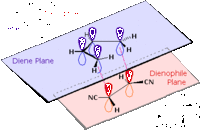
Modelling Techniques & Calculations
The computational models may be built from ChemDraw structural drawings, which convert to 3D structures in Chem3D, or by direct modelling in GaussView. Optimisations may be run by MM2 (molecular mechanics) or PM6 (semi-empirical molecular orbital theory) in Chem3D. The principale method here is the use of Gaussian to run molecular orbital-based quantum calculations - numerically solving the Schroedinger equation - giving a more accurate result.
The Diels-Alder Cycloaddition
A Diels Alder reaction is a pericyclic reaction between a diene and a dieneophile, the π orbitals of the two species interacting to form new σ bonds. For such a reaction to be allowed the HOMO of one reactant must interact with the LUMO of the other (forming two new MOs, one bonding and one anti-bonding). Furthermore, for a reaction there must be good orbital overlap; differing symmetry makes this impossible and the reaction forbidden.
The addition of substituents (with π orbitals) to the dieneophile stabilises the regiochemistry of the addition by interacting with the new double bond on the product (known as secondary orbital effects).
The transition structures for Diels-Alder cycloadditions - with both substituted and unsubstituted dieneophiles - are determined, considering the MOs also, to predicted reactivity. Under kinetic control the product with the lower energy transition state dominates, as illustrated below.
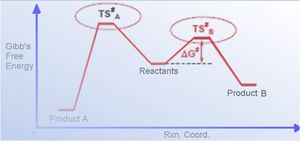
Prototypical Diels-Alder cycloaddition: ethylene + cis-butadiene
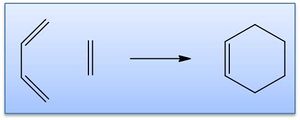
The reaction scheme between ethylene and butadiene to give cyclohexene via a Diels-Alder cycloaddition is shown right. The way in which the reactants come together in the transition state is governed by π orbital interactions, principally the HOMO and LUMO of each. In this case there is a [4s + 2s] addition (this reflects the number of π orbitals present). The MO interactions are considered in more detail below, with the transition states of such cycloadditions to predict reactivity.
MO analysis of cis-butadiene
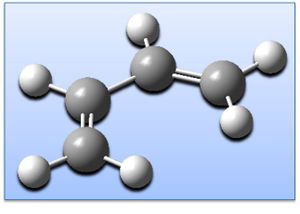
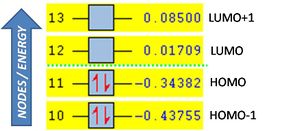
Cis-butadiene has been geometry optimised (AM1 level) giving the structure shown right (click to enlarge & click button for 3D JMol). Optimisation is confirmed in the .log output file and by frequency (vibrational) analysis - there are no imaginary frequencies and thus a global minima has been achieved:
Optimization completed.
-- Stationary point found.
Low frequencies --- -39.4465 -5.9826 -2.0934 -0.0224 0.0035 0.1061 Low frequencies --- 6.5194 312.6368 485.2126
The thermal energies of the system are noted:
Sum of electronic and zero-point Energies= 0.134553 Sum of electronic and thermal Energies= 0.138573 Sum of electronic and thermal Enthalpies= 0.139517 Sum of electronic and thermal Free Energies= 0.108518
The HOMO and LUMO are shown below with their symmetry relative to a vertical plane (sketched).

Notably the HOMO is anti-symmetric and the LUMO symmetric, and the number of nodes increases with the energy of the MO (energies are shown right).
Optimising the transition structures
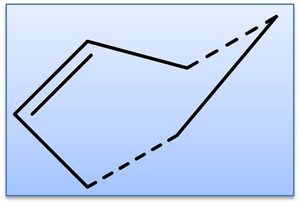
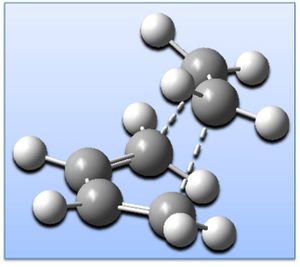
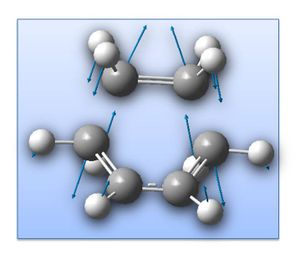
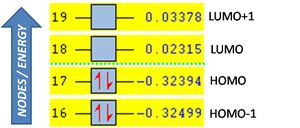
The transition state for the reaction between ethylene and cis-butadiene is known to have an envelope type structure to maximise the π orbital overlap between the reactants. The transition state structure has been optimised from an initial guess, shown right (AM1 level). Simultaneous frequency analysis confirms this to be a transition state by the presence of an imaginary vibration:
Low frequencies --- -956.1133 -3.7882 -2.8348 -0.4038 -0.0031 0.0485 Low frequencies --- 0.0842 147.2135 246.6165
The thermal energies of the system are noted:
Sum of electronic and zero-point Energies= 0.253277 Sum of electronic and thermal Energies= 0.259454 Sum of electronic and thermal Enthalpies= 0.260398 Sum of electronic and thermal Free Energies= 0.224017
Animation of the imaginary vibration corresponds to the pericyclic reaction as the two fragments come together (shown right - click to enlarge).
The principal MOs of the transition state and their symmetry are described below, their relative energies being plotted right.

Notably the HOMO has three nodes creating six clouds of electron density in an antisymmetric array about the plane shown.
Regioselectivity of the Diels-Alder reaction
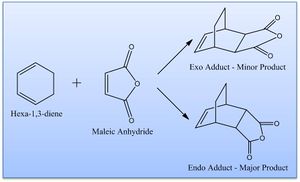
It is known that cyclohexa-1,3-diene reacts with maleic anhydride giving the endo adduct as the major product - this is supposed to be a result of kinetic control and the exo transition state being higher in energy. The reaction is shown right.
The transition structures leading to both products are shown below, with their corresponding energies below and C-C 'bond' distances tabulated.

The energies of the endo transition state are noted:
Sum of electronic and zero-point Energies= 0.197460 Sum of electronic and thermal Energies= 0.209215 Sum of electronic and thermal Enthalpies= 0.210159 Sum of electronic and thermal Free Energies= 0.157598
And the principal MOs illustrated below.

And of the exo transition state:
Sum of electronic and zero-point Energies= 0.197458 Sum of electronic and thermal Energies= 0.209214 Sum of electronic and thermal Enthalpies= 0.210158 Sum of electronic and thermal Free Energies= 0.157589
Again the principal MOs are again shown below.

The sum of free energies for the endo transition state are higher than for the exo; the C-C 'bond' distances are highly similar in both cases, as is the general shape of the MOs, and their energies.
- What can you conclude about the so called “secondary orbital overlap effect”?
Discussion
Use this template as a guide. Screen images can be saved from the GaussView File menu.
For cis butadiene: Plot the HOMO and LUMO and determine the symmetry (symmetric or anti-symmetric) with respect to the plane.
For the ethylene+cis butadiene transition structure: Sketch HOMO and LUMO, labeling each as symmetric or anti symmetric.
Show the geometry of the transition structure, including the bond-lengths of the partly formed σ C-C bonds.
What are typical sp3 and sp2 C-C bondlengths? What is the van der Waals radius of the C atom? What can you conclude about the C-C bondlength of the partly formed σ C-C bonds in the TS.
Illustrate the vibration that corresponds to the reaction path at the transition state. Is the formation of the two bonds synchronous or asynchronous? How does this compare with the lowest positive frequency?
Is the HOMO at the transition structure s or a?
Which MOs of butadiene and ethylene have been used to form this MO? Explain why the reaction is allowed.
For the cyclohexa-1,3-diene reaction with maleic anhydride: Give the relative energies of the exo and endo transition structures. Comment on the structural difference between the endo and exo form. Why do you think that the exo form could be more strained? Examine carefully the nodal properties of the HOMO between the -(C=O)-O-(C=O)- fragment and the remainder of the system. What can you conclude about the so called “secondary orbital overlap effect”? (There is some discussion of this in Ian Fleming's book 'Frontier Orbitals and Organic Chemical Reactions').
Further discussion: What effects have been neglected in these calculations of Diels Alder transition states?
Look at published examples and investigate further if you have time. (e.g. DOI:10.1021/jo0348827 )
Error analysis...
Calculated energies are accurate to ~10kJ/mol - 0.003809a.u. - and are thus reported to 0.01a.u.; dipole moments are accurate to 0.01 Debye, and frequencies reported to 1cm-1 (typically 10% error), likewise intensities (infrared) are given as whole numbers; bond distances are accurate to 0.01a.u. and angles to 0.1deg.
Notably energies between molecules should only be considered on a relative (kJ/mol; not absolute!) level; absolute values are noted for reproducibility only (a.u.), and consistency is paramount for comparison (basis set, method, details).
References
External links
- [Michigan State University - Reactions of Alkenes: http://www.cem.msu.edu/~reusch/VirtualText/addene2.htm]
- [Chemistry SCAN Link: https://scanweb.cc.imperial.ac.uk/uportal2/]
- [Illustration of vibrational mode categories: http://en.wikipedia.org/wiki/Infrared_spectroscopy]
- [Online symmetry point group flow chart: http://capsicum.me.utexas.edu/ChE386K/Images/point_group_flowchart_shriver.jpg]
